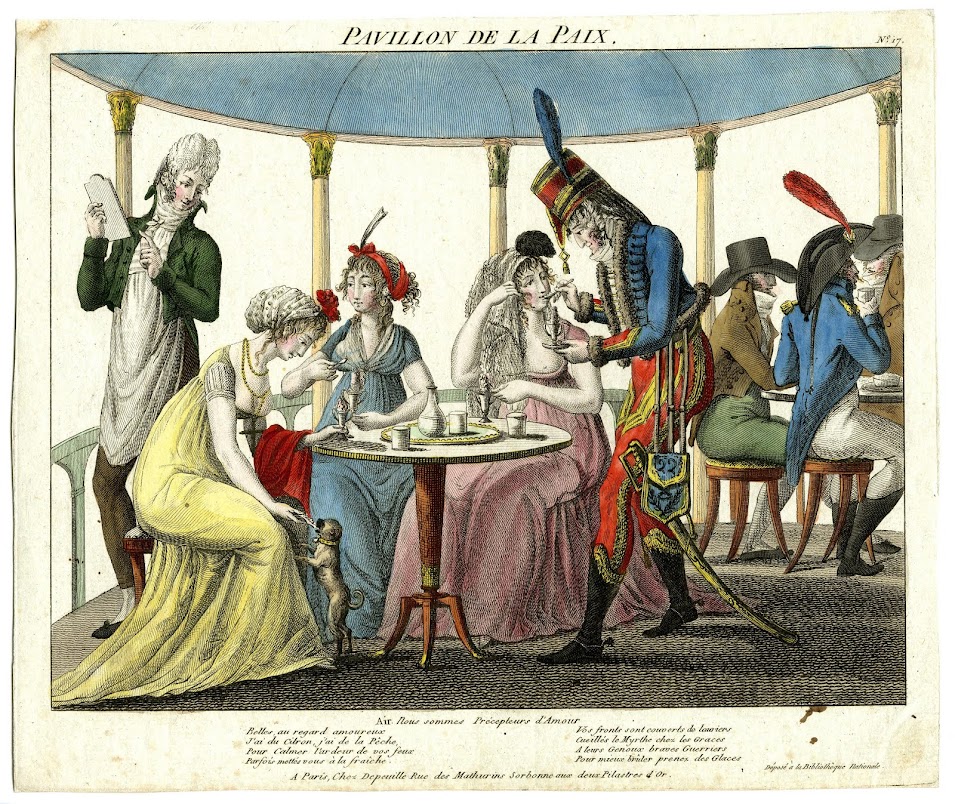If you've ever have a chance to attend a class given by her, don't let it pass. You will discover that, despite being a more or less advanced dancer (I started figure ice-skating aged 6 1/2, and never stopped dancing since), you suddenly develop yet another pair of left feet and the pleasure to sort them out.
Evidently, I continued to practice the steps, and feel now more or less confident and less muddled when hopping about. Oddly enough, the pictures of the Bon Genre started to make more sense, and after having hopped, slided, muddled through figures as diagonal chains in La Poule (In Scottish Country Dance terms: Think chain with corners, Strahtspey-step and some additional hopping...)
La Poule is one figure in a Quadrille. Early Quadrille are quite dissimilar to their Belle-Epoque counterparts, as they are danced with some complicated steps, what require training. The Term "Quadrille" is usually applied to a dance set of 8 dancers (4 couples), but the same dance can also be danced by 4 dancers, in a "Quadrette". We started of by "Le Pantalon", followed by "L'été", then "La Poule" - the one you see up there, though we've ended all the ladies facing up and the gentlemen facing down, followed by "La Trénis and La Sirie", ending with "L'Austerlitz"
We danced the Trénis to a tune with audibly took it's inspiration of "Partant pour la Syrie"what is claimed to be written by Hortense de Beauharnais (or possibly one of her music teachers. Hortense was an accomplished dancer and musician, it's not without cause that the song was attributed to her)
If you'd like to hear that song, check Paula Bär-Gieses's Video (She's delightful).
Back to La Trénis: As you can see in the picture - the gentleman on the right does the same as we did: wiping his forehead and wondering "How many feet do I have?"
After the quadrille comes the valse:
Just look at this delightful depiction of waltzing :-)Annie introduced us to the differences between the valse as depicted by Wilson (in 1816) and the modern valse. For me the most striking difference is the lack of the 123123123 what we find in modern dance, but an even 1-2-3-1-2-3-1-2-3. Once mastered, it makes for a rather harmonic dance. Once mastered, mind.
The Valse (what Wilson calls the French Waltz) is built as followed: Marching, then followed by the Slow Waltz. The Sauteuse succeeds the Slow. Sauteuse can be translated into "hopping" - and hopping it is. The issue for my balance-sense: As the valse is danced in a very small circle with your partner, one is turning constantly and much faster than in a modern waltz - and with the sauteuse the speed improves. After the Sauteuses followes the "Quick" - what had me flattened out on the floor, my poor head was spinning so much!
| Again, Pierre La Mésangère, British Museum, Acc. No 1866,0407.882: La Sauteuse: Two couples dance energetically ca 1812 |
And practicing alone in front of a mirror is period too ;-)
